Organisational Management Report: Functions and Structure Analysis
VerifiedAdded on 2020/09/03
|14
|3170
|41
Report
AI Summary
This report provides a detailed analysis of organisational management, focusing on key functions such as human resource management and customer service within the context of Home Food. It explores the aims of these functions, including staffing, employee satisfaction, and building coordination between departments. The report also examines the contribution of an effective organisational structure to business success, emphasizing the relationship between structure, employee creativity, and commitment. Furthermore, it touches upon the importance of societal and ethical models in human resource management and the various types of customer service skills required for delivering good services. The report also discusses rules of good customer service and the role of customer service in the digital market, highlighting how customer service contributes to market promotions and overall productivity. The report also includes the role of an effective organisational structure on the creativity of the organisation.
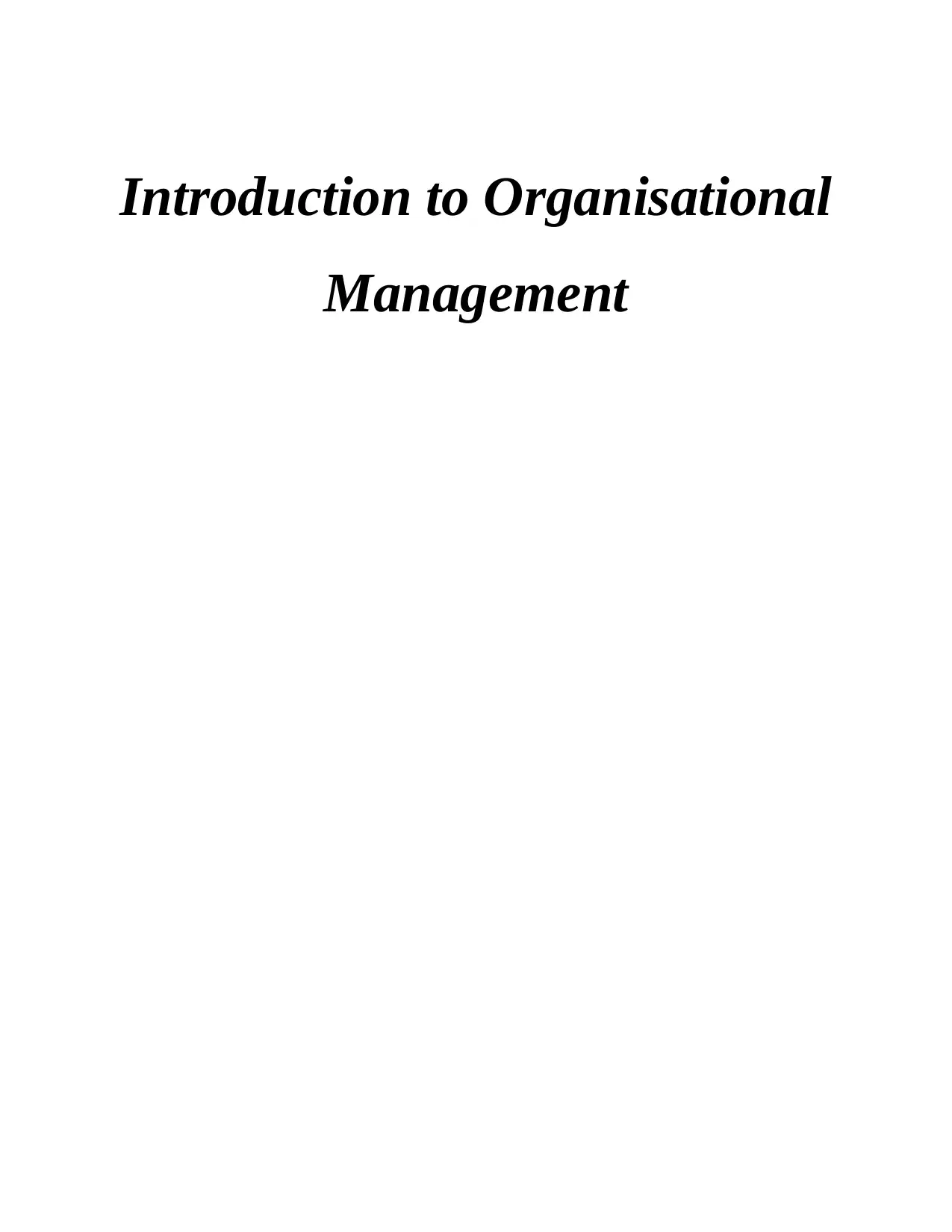
Introduction to Organisational
Management
Management
Paraphrase This Document
Need a fresh take? Get an instant paraphrase of this document with our AI Paraphraser
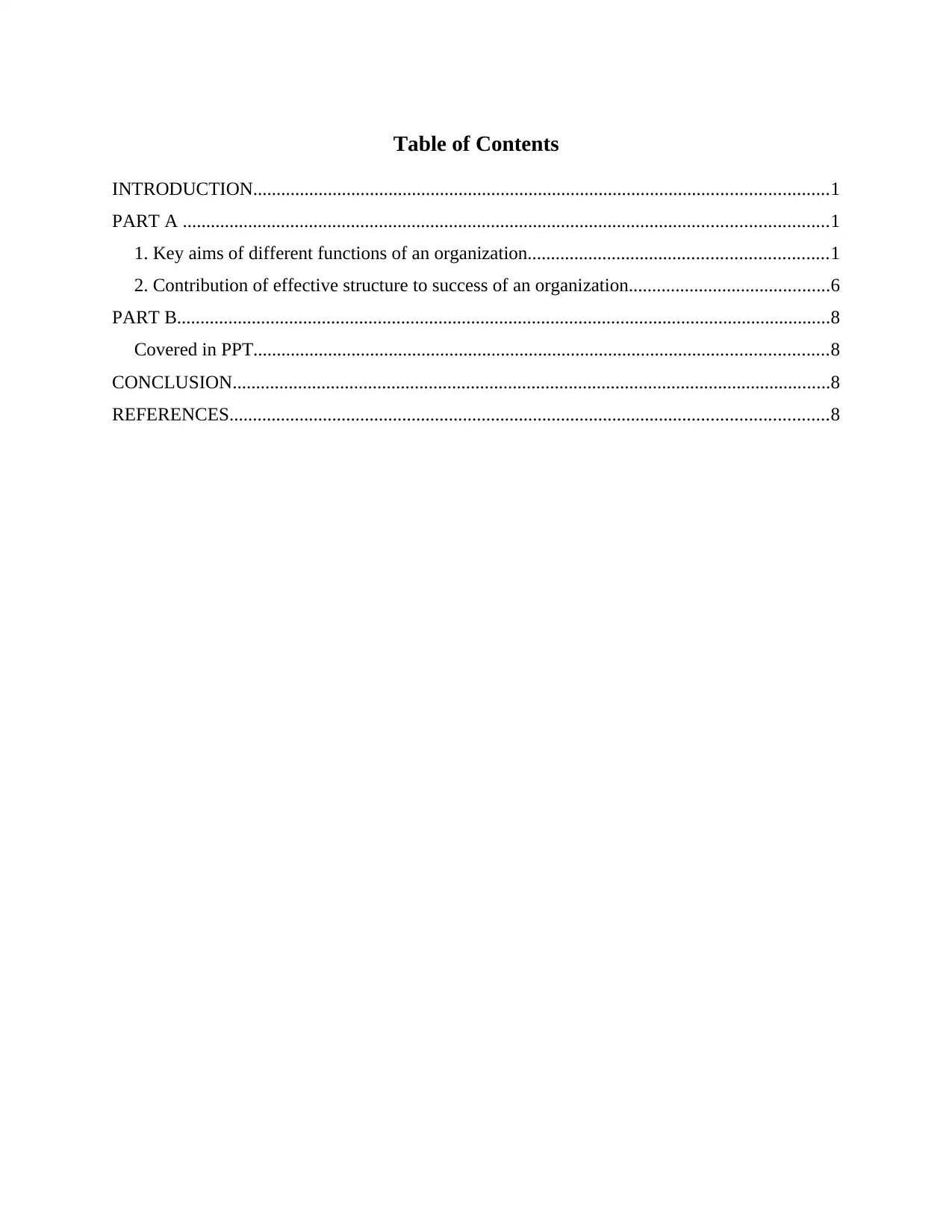
Table of Contents
INTRODUCTION...........................................................................................................................1
PART A ..........................................................................................................................................1
1. Key aims of different functions of an organization................................................................1
2. Contribution of effective structure to success of an organization...........................................6
PART B............................................................................................................................................8
Covered in PPT...........................................................................................................................8
CONCLUSION................................................................................................................................8
REFERENCES................................................................................................................................8
INTRODUCTION...........................................................................................................................1
PART A ..........................................................................................................................................1
1. Key aims of different functions of an organization................................................................1
2. Contribution of effective structure to success of an organization...........................................6
PART B............................................................................................................................................8
Covered in PPT...........................................................................................................................8
CONCLUSION................................................................................................................................8
REFERENCES................................................................................................................................8
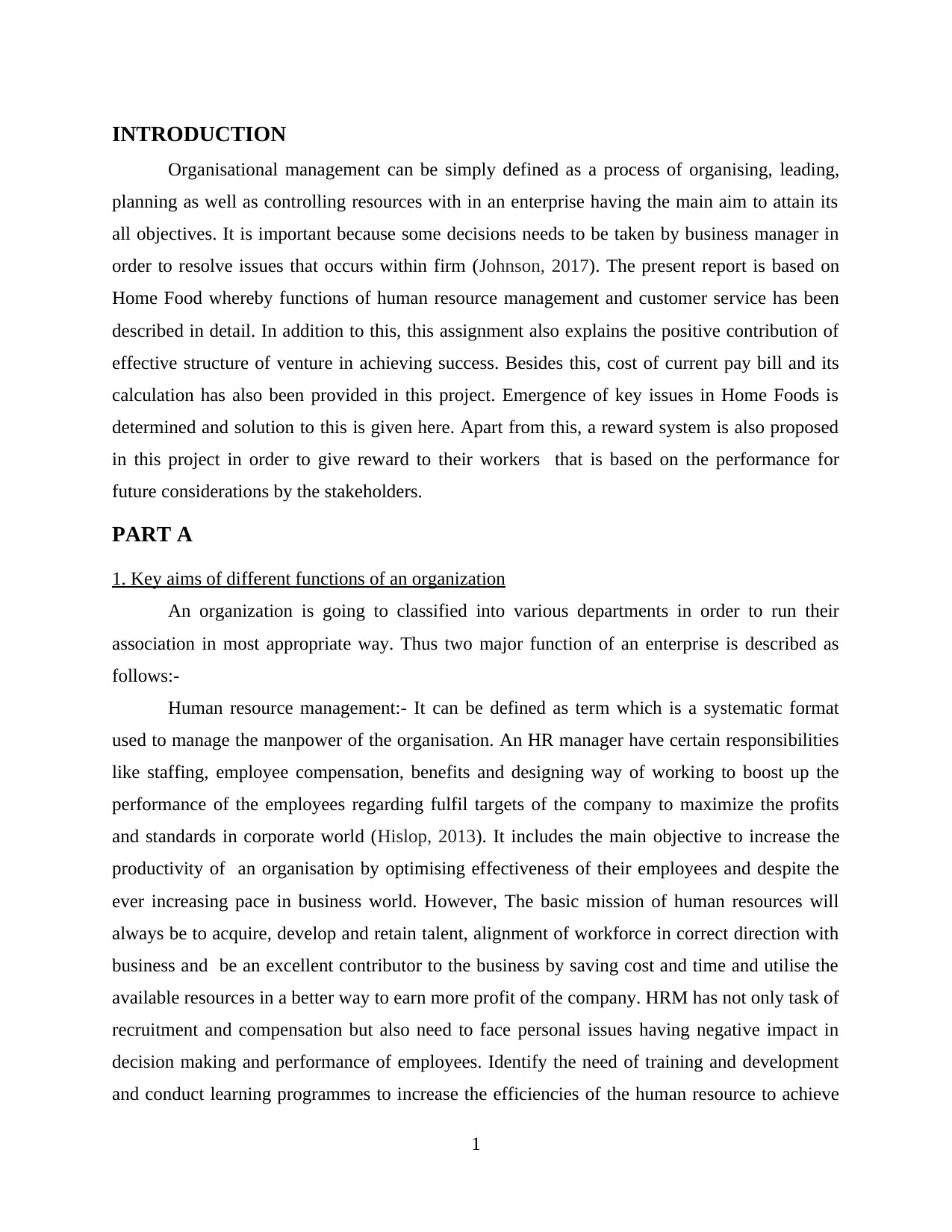
INTRODUCTION
Organisational management can be simply defined as a process of organising, leading,
planning as well as controlling resources with in an enterprise having the main aim to attain its
all objectives. It is important because some decisions needs to be taken by business manager in
order to resolve issues that occurs within firm (Johnson, 2017). The present report is based on
Home Food whereby functions of human resource management and customer service has been
described in detail. In addition to this, this assignment also explains the positive contribution of
effective structure of venture in achieving success. Besides this, cost of current pay bill and its
calculation has also been provided in this project. Emergence of key issues in Home Foods is
determined and solution to this is given here. Apart from this, a reward system is also proposed
in this project in order to give reward to their workers that is based on the performance for
future considerations by the stakeholders.
PART A
1. Key aims of different functions of an organization
An organization is going to classified into various departments in order to run their
association in most appropriate way. Thus two major function of an enterprise is described as
follows:-
Human resource management:- It can be defined as term which is a systematic format
used to manage the manpower of the organisation. An HR manager have certain responsibilities
like staffing, employee compensation, benefits and designing way of working to boost up the
performance of the employees regarding fulfil targets of the company to maximize the profits
and standards in corporate world (Hislop, 2013). It includes the main objective to increase the
productivity of an organisation by optimising effectiveness of their employees and despite the
ever increasing pace in business world. However, The basic mission of human resources will
always be to acquire, develop and retain talent, alignment of workforce in correct direction with
business and be an excellent contributor to the business by saving cost and time and utilise the
available resources in a better way to earn more profit of the company. HRM has not only task of
recruitment and compensation but also need to face personal issues having negative impact in
decision making and performance of employees. Identify the need of training and development
and conduct learning programmes to increase the efficiencies of the human resource to achieve
1
Organisational management can be simply defined as a process of organising, leading,
planning as well as controlling resources with in an enterprise having the main aim to attain its
all objectives. It is important because some decisions needs to be taken by business manager in
order to resolve issues that occurs within firm (Johnson, 2017). The present report is based on
Home Food whereby functions of human resource management and customer service has been
described in detail. In addition to this, this assignment also explains the positive contribution of
effective structure of venture in achieving success. Besides this, cost of current pay bill and its
calculation has also been provided in this project. Emergence of key issues in Home Foods is
determined and solution to this is given here. Apart from this, a reward system is also proposed
in this project in order to give reward to their workers that is based on the performance for
future considerations by the stakeholders.
PART A
1. Key aims of different functions of an organization
An organization is going to classified into various departments in order to run their
association in most appropriate way. Thus two major function of an enterprise is described as
follows:-
Human resource management:- It can be defined as term which is a systematic format
used to manage the manpower of the organisation. An HR manager have certain responsibilities
like staffing, employee compensation, benefits and designing way of working to boost up the
performance of the employees regarding fulfil targets of the company to maximize the profits
and standards in corporate world (Hislop, 2013). It includes the main objective to increase the
productivity of an organisation by optimising effectiveness of their employees and despite the
ever increasing pace in business world. However, The basic mission of human resources will
always be to acquire, develop and retain talent, alignment of workforce in correct direction with
business and be an excellent contributor to the business by saving cost and time and utilise the
available resources in a better way to earn more profit of the company. HRM has not only task of
recruitment and compensation but also need to face personal issues having negative impact in
decision making and performance of employees. Identify the need of training and development
and conduct learning programmes to increase the efficiencies of the human resource to achieve
1
⊘ This is a preview!⊘
Do you want full access?
Subscribe today to unlock all pages.

Trusted by 1+ million students worldwide
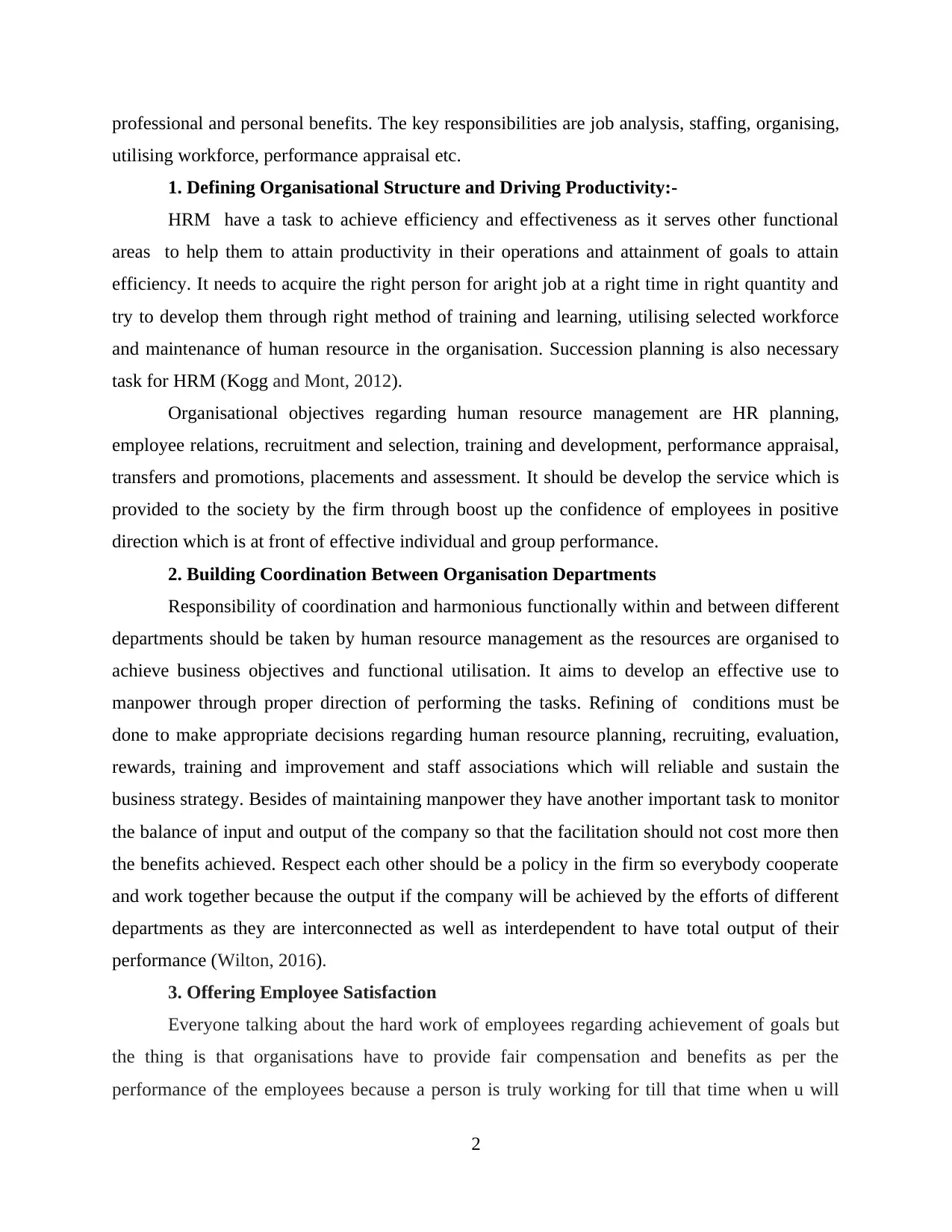
professional and personal benefits. The key responsibilities are job analysis, staffing, organising,
utilising workforce, performance appraisal etc.
1. Defining Organisational Structure and Driving Productivity:-
HRM have a task to achieve efficiency and effectiveness as it serves other functional
areas to help them to attain productivity in their operations and attainment of goals to attain
efficiency. It needs to acquire the right person for aright job at a right time in right quantity and
try to develop them through right method of training and learning, utilising selected workforce
and maintenance of human resource in the organisation. Succession planning is also necessary
task for HRM (Kogg and Mont, 2012).
Organisational objectives regarding human resource management are HR planning,
employee relations, recruitment and selection, training and development, performance appraisal,
transfers and promotions, placements and assessment. It should be develop the service which is
provided to the society by the firm through boost up the confidence of employees in positive
direction which is at front of effective individual and group performance.
2. Building Coordination Between Organisation Departments
Responsibility of coordination and harmonious functionally within and between different
departments should be taken by human resource management as the resources are organised to
achieve business objectives and functional utilisation. It aims to develop an effective use to
manpower through proper direction of performing the tasks. Refining of conditions must be
done to make appropriate decisions regarding human resource planning, recruiting, evaluation,
rewards, training and improvement and staff associations which will reliable and sustain the
business strategy. Besides of maintaining manpower they have another important task to monitor
the balance of input and output of the company so that the facilitation should not cost more then
the benefits achieved. Respect each other should be a policy in the firm so everybody cooperate
and work together because the output if the company will be achieved by the efforts of different
departments as they are interconnected as well as interdependent to have total output of their
performance (Wilton, 2016).
3. Offering Employee Satisfaction
Everyone talking about the hard work of employees regarding achievement of goals but
the thing is that organisations have to provide fair compensation and benefits as per the
performance of the employees because a person is truly working for till that time when u will
2
utilising workforce, performance appraisal etc.
1. Defining Organisational Structure and Driving Productivity:-
HRM have a task to achieve efficiency and effectiveness as it serves other functional
areas to help them to attain productivity in their operations and attainment of goals to attain
efficiency. It needs to acquire the right person for aright job at a right time in right quantity and
try to develop them through right method of training and learning, utilising selected workforce
and maintenance of human resource in the organisation. Succession planning is also necessary
task for HRM (Kogg and Mont, 2012).
Organisational objectives regarding human resource management are HR planning,
employee relations, recruitment and selection, training and development, performance appraisal,
transfers and promotions, placements and assessment. It should be develop the service which is
provided to the society by the firm through boost up the confidence of employees in positive
direction which is at front of effective individual and group performance.
2. Building Coordination Between Organisation Departments
Responsibility of coordination and harmonious functionally within and between different
departments should be taken by human resource management as the resources are organised to
achieve business objectives and functional utilisation. It aims to develop an effective use to
manpower through proper direction of performing the tasks. Refining of conditions must be
done to make appropriate decisions regarding human resource planning, recruiting, evaluation,
rewards, training and improvement and staff associations which will reliable and sustain the
business strategy. Besides of maintaining manpower they have another important task to monitor
the balance of input and output of the company so that the facilitation should not cost more then
the benefits achieved. Respect each other should be a policy in the firm so everybody cooperate
and work together because the output if the company will be achieved by the efforts of different
departments as they are interconnected as well as interdependent to have total output of their
performance (Wilton, 2016).
3. Offering Employee Satisfaction
Everyone talking about the hard work of employees regarding achievement of goals but
the thing is that organisations have to provide fair compensation and benefits as per the
performance of the employees because a person is truly working for till that time when u will
2
Paraphrase This Document
Need a fresh take? Get an instant paraphrase of this document with our AI Paraphraser
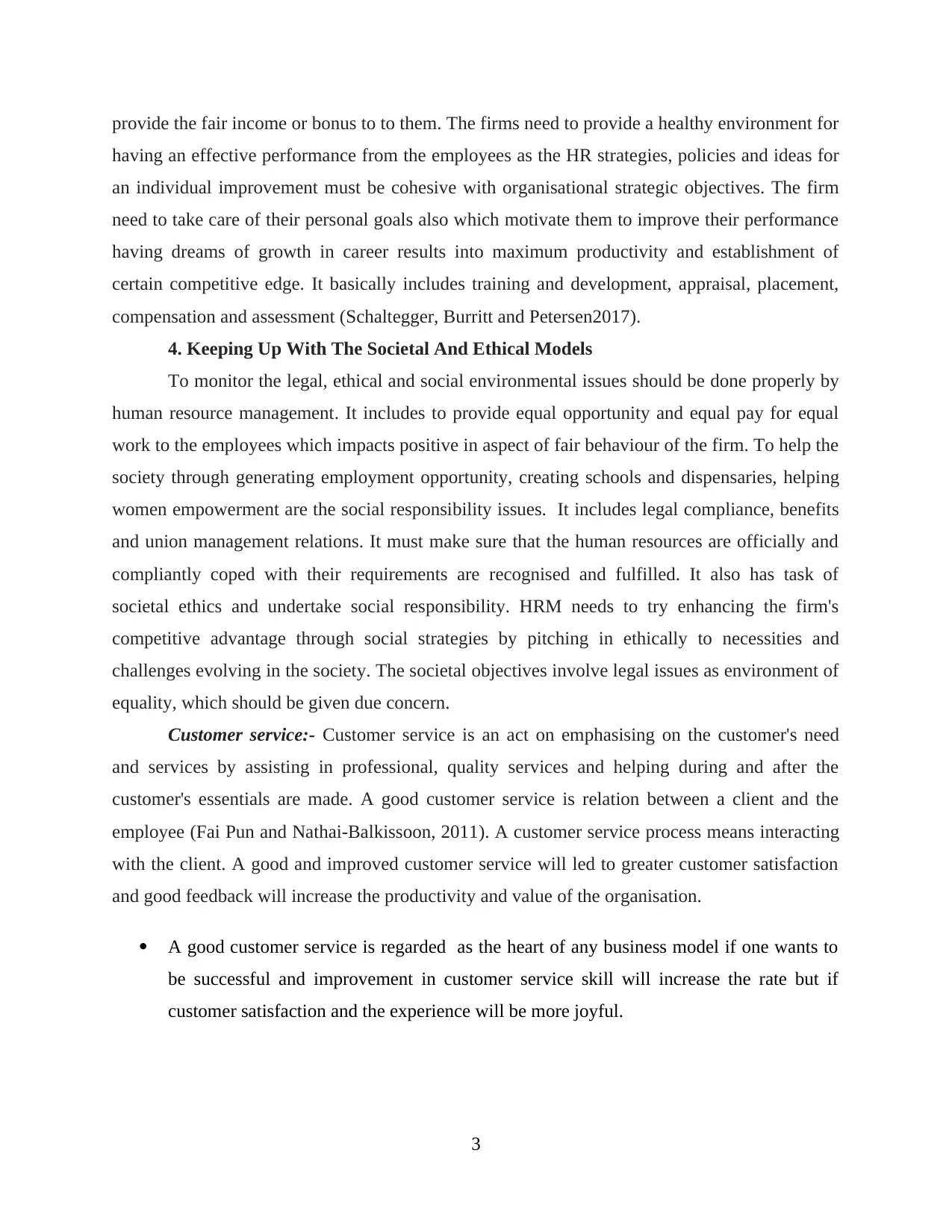
provide the fair income or bonus to to them. The firms need to provide a healthy environment for
having an effective performance from the employees as the HR strategies, policies and ideas for
an individual improvement must be cohesive with organisational strategic objectives. The firm
need to take care of their personal goals also which motivate them to improve their performance
having dreams of growth in career results into maximum productivity and establishment of
certain competitive edge. It basically includes training and development, appraisal, placement,
compensation and assessment (Schaltegger, Burritt and Petersen2017).
4. Keeping Up With The Societal And Ethical Models
To monitor the legal, ethical and social environmental issues should be done properly by
human resource management. It includes to provide equal opportunity and equal pay for equal
work to the employees which impacts positive in aspect of fair behaviour of the firm. To help the
society through generating employment opportunity, creating schools and dispensaries, helping
women empowerment are the social responsibility issues. It includes legal compliance, benefits
and union management relations. It must make sure that the human resources are officially and
compliantly coped with their requirements are recognised and fulfilled. It also has task of
societal ethics and undertake social responsibility. HRM needs to try enhancing the firm's
competitive advantage through social strategies by pitching in ethically to necessities and
challenges evolving in the society. The societal objectives involve legal issues as environment of
equality, which should be given due concern.
Customer service:- Customer service is an act on emphasising on the customer's need
and services by assisting in professional, quality services and helping during and after the
customer's essentials are made. A good customer service is relation between a client and the
employee (Fai Pun and Nathai-Balkissoon, 2011). A customer service process means interacting
with the client. A good and improved customer service will led to greater customer satisfaction
and good feedback will increase the productivity and value of the organisation.
A good customer service is regarded as the heart of any business model if one wants to
be successful and improvement in customer service skill will increase the rate but if
customer satisfaction and the experience will be more joyful.
3
having an effective performance from the employees as the HR strategies, policies and ideas for
an individual improvement must be cohesive with organisational strategic objectives. The firm
need to take care of their personal goals also which motivate them to improve their performance
having dreams of growth in career results into maximum productivity and establishment of
certain competitive edge. It basically includes training and development, appraisal, placement,
compensation and assessment (Schaltegger, Burritt and Petersen2017).
4. Keeping Up With The Societal And Ethical Models
To monitor the legal, ethical and social environmental issues should be done properly by
human resource management. It includes to provide equal opportunity and equal pay for equal
work to the employees which impacts positive in aspect of fair behaviour of the firm. To help the
society through generating employment opportunity, creating schools and dispensaries, helping
women empowerment are the social responsibility issues. It includes legal compliance, benefits
and union management relations. It must make sure that the human resources are officially and
compliantly coped with their requirements are recognised and fulfilled. It also has task of
societal ethics and undertake social responsibility. HRM needs to try enhancing the firm's
competitive advantage through social strategies by pitching in ethically to necessities and
challenges evolving in the society. The societal objectives involve legal issues as environment of
equality, which should be given due concern.
Customer service:- Customer service is an act on emphasising on the customer's need
and services by assisting in professional, quality services and helping during and after the
customer's essentials are made. A good customer service is relation between a client and the
employee (Fai Pun and Nathai-Balkissoon, 2011). A customer service process means interacting
with the client. A good and improved customer service will led to greater customer satisfaction
and good feedback will increase the productivity and value of the organisation.
A good customer service is regarded as the heart of any business model if one wants to
be successful and improvement in customer service skill will increase the rate but if
customer satisfaction and the experience will be more joyful.
3
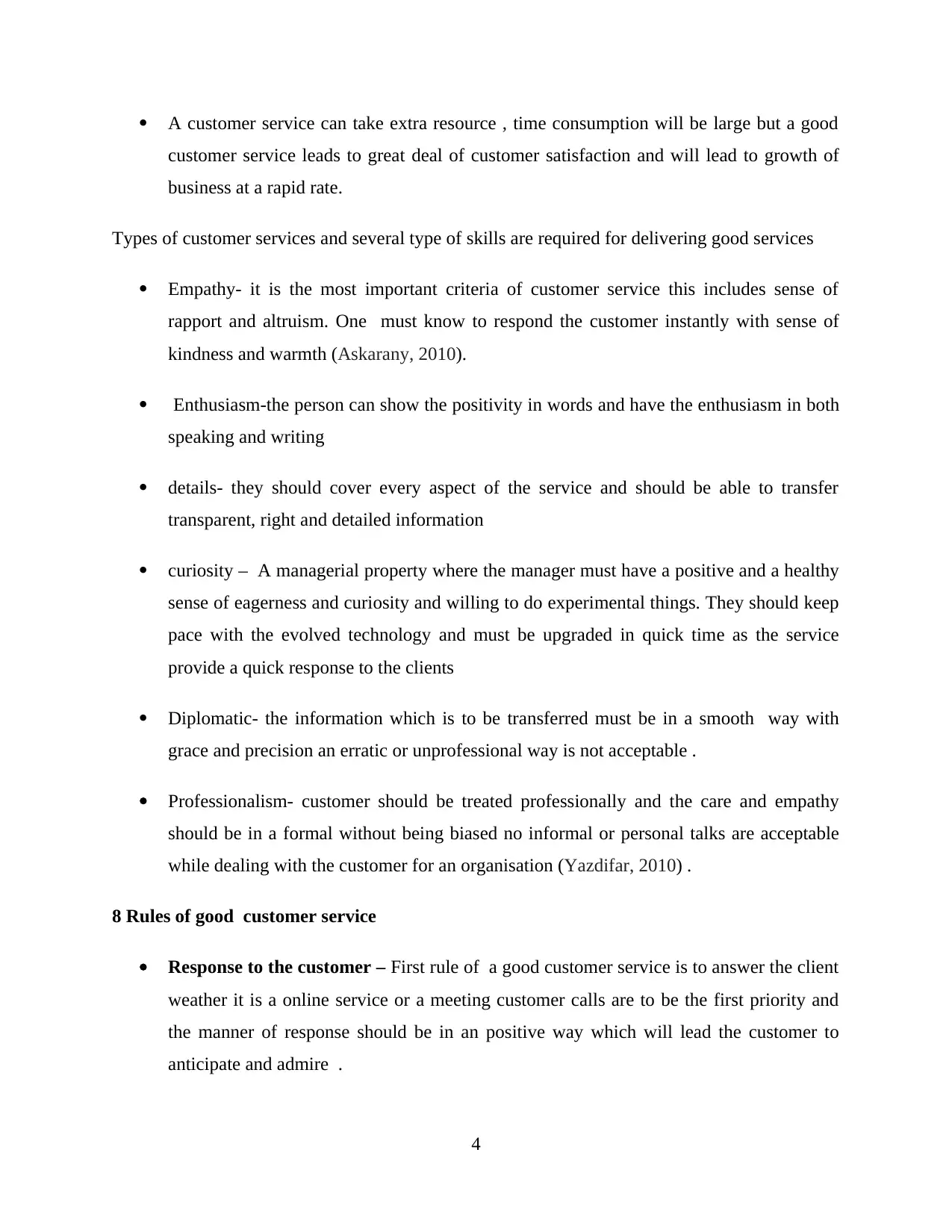
A customer service can take extra resource , time consumption will be large but a good
customer service leads to great deal of customer satisfaction and will lead to growth of
business at a rapid rate.
Types of customer services and several type of skills are required for delivering good services
Empathy- it is the most important criteria of customer service this includes sense of
rapport and altruism. One must know to respond the customer instantly with sense of
kindness and warmth (Askarany, 2010).
Enthusiasm-the person can show the positivity in words and have the enthusiasm in both
speaking and writing
details- they should cover every aspect of the service and should be able to transfer
transparent, right and detailed information
curiosity – A managerial property where the manager must have a positive and a healthy
sense of eagerness and curiosity and willing to do experimental things. They should keep
pace with the evolved technology and must be upgraded in quick time as the service
provide a quick response to the clients
Diplomatic- the information which is to be transferred must be in a smooth way with
grace and precision an erratic or unprofessional way is not acceptable .
Professionalism- customer should be treated professionally and the care and empathy
should be in a formal without being biased no informal or personal talks are acceptable
while dealing with the customer for an organisation (Yazdifar, 2010) .
8 Rules of good customer service
Response to the customer – First rule of a good customer service is to answer the client
weather it is a online service or a meeting customer calls are to be the first priority and
the manner of response should be in an positive way which will lead the customer to
anticipate and admire .
4
customer service leads to great deal of customer satisfaction and will lead to growth of
business at a rapid rate.
Types of customer services and several type of skills are required for delivering good services
Empathy- it is the most important criteria of customer service this includes sense of
rapport and altruism. One must know to respond the customer instantly with sense of
kindness and warmth (Askarany, 2010).
Enthusiasm-the person can show the positivity in words and have the enthusiasm in both
speaking and writing
details- they should cover every aspect of the service and should be able to transfer
transparent, right and detailed information
curiosity – A managerial property where the manager must have a positive and a healthy
sense of eagerness and curiosity and willing to do experimental things. They should keep
pace with the evolved technology and must be upgraded in quick time as the service
provide a quick response to the clients
Diplomatic- the information which is to be transferred must be in a smooth way with
grace and precision an erratic or unprofessional way is not acceptable .
Professionalism- customer should be treated professionally and the care and empathy
should be in a formal without being biased no informal or personal talks are acceptable
while dealing with the customer for an organisation (Yazdifar, 2010) .
8 Rules of good customer service
Response to the customer – First rule of a good customer service is to answer the client
weather it is a online service or a meeting customer calls are to be the first priority and
the manner of response should be in an positive way which will lead the customer to
anticipate and admire .
4
⊘ This is a preview!⊘
Do you want full access?
Subscribe today to unlock all pages.

Trusted by 1+ million students worldwide
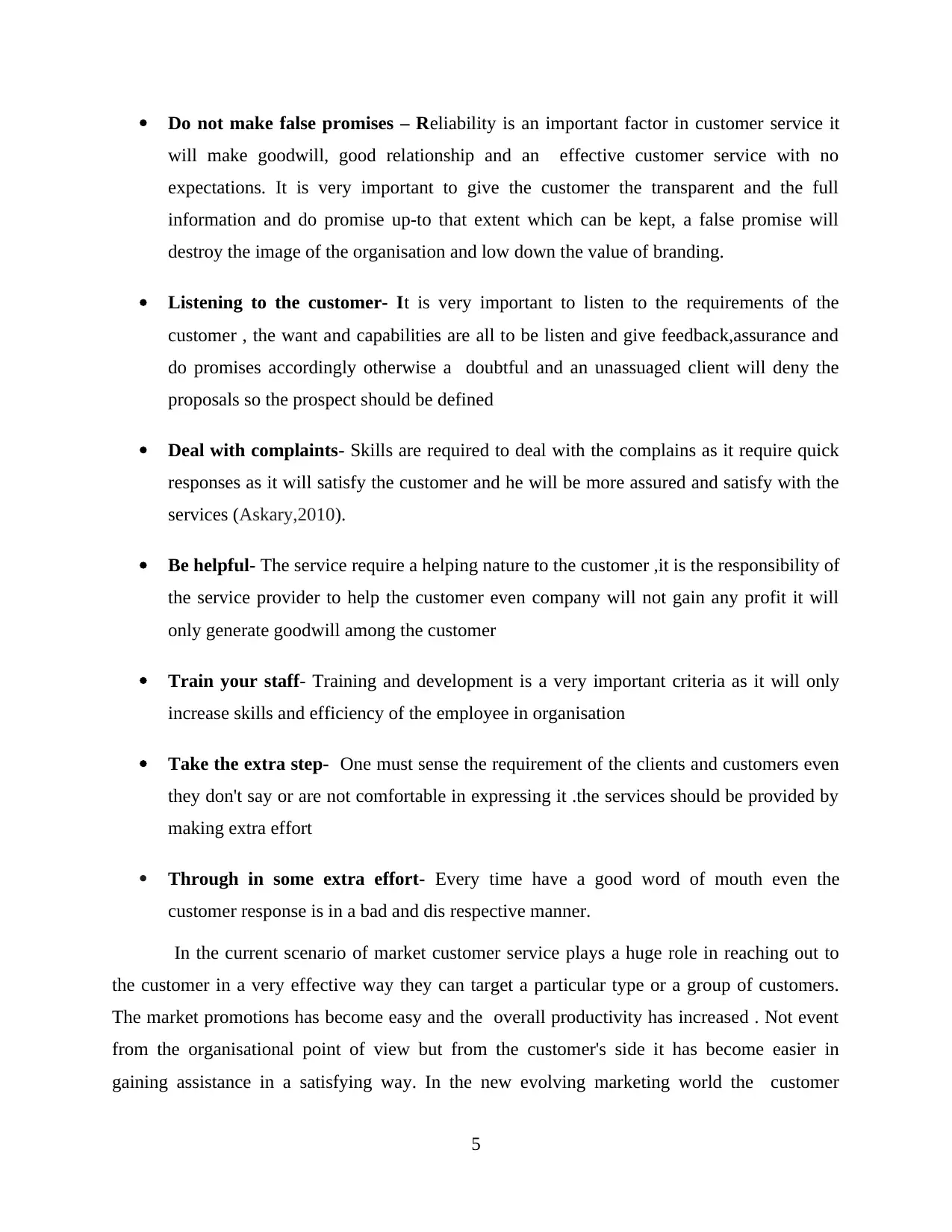
Do not make false promises – Reliability is an important factor in customer service it
will make goodwill, good relationship and an effective customer service with no
expectations. It is very important to give the customer the transparent and the full
information and do promise up-to that extent which can be kept, a false promise will
destroy the image of the organisation and low down the value of branding.
Listening to the customer- It is very important to listen to the requirements of the
customer , the want and capabilities are all to be listen and give feedback,assurance and
do promises accordingly otherwise a doubtful and an unassuaged client will deny the
proposals so the prospect should be defined
Deal with complaints- Skills are required to deal with the complains as it require quick
responses as it will satisfy the customer and he will be more assured and satisfy with the
services (Askary,2010).
Be helpful- The service require a helping nature to the customer ,it is the responsibility of
the service provider to help the customer even company will not gain any profit it will
only generate goodwill among the customer
Train your staff- Training and development is a very important criteria as it will only
increase skills and efficiency of the employee in organisation
Take the extra step- One must sense the requirement of the clients and customers even
they don't say or are not comfortable in expressing it .the services should be provided by
making extra effort
Through in some extra effort- Every time have a good word of mouth even the
customer response is in a bad and dis respective manner.
In the current scenario of market customer service plays a huge role in reaching out to
the customer in a very effective way they can target a particular type or a group of customers.
The market promotions has become easy and the overall productivity has increased . Not event
from the organisational point of view but from the customer's side it has become easier in
gaining assistance in a satisfying way. In the new evolving marketing world the customer
5
will make goodwill, good relationship and an effective customer service with no
expectations. It is very important to give the customer the transparent and the full
information and do promise up-to that extent which can be kept, a false promise will
destroy the image of the organisation and low down the value of branding.
Listening to the customer- It is very important to listen to the requirements of the
customer , the want and capabilities are all to be listen and give feedback,assurance and
do promises accordingly otherwise a doubtful and an unassuaged client will deny the
proposals so the prospect should be defined
Deal with complaints- Skills are required to deal with the complains as it require quick
responses as it will satisfy the customer and he will be more assured and satisfy with the
services (Askary,2010).
Be helpful- The service require a helping nature to the customer ,it is the responsibility of
the service provider to help the customer even company will not gain any profit it will
only generate goodwill among the customer
Train your staff- Training and development is a very important criteria as it will only
increase skills and efficiency of the employee in organisation
Take the extra step- One must sense the requirement of the clients and customers even
they don't say or are not comfortable in expressing it .the services should be provided by
making extra effort
Through in some extra effort- Every time have a good word of mouth even the
customer response is in a bad and dis respective manner.
In the current scenario of market customer service plays a huge role in reaching out to
the customer in a very effective way they can target a particular type or a group of customers.
The market promotions has become easy and the overall productivity has increased . Not event
from the organisational point of view but from the customer's side it has become easier in
gaining assistance in a satisfying way. In the new evolving marketing world the customer
5
Paraphrase This Document
Need a fresh take? Get an instant paraphrase of this document with our AI Paraphraser
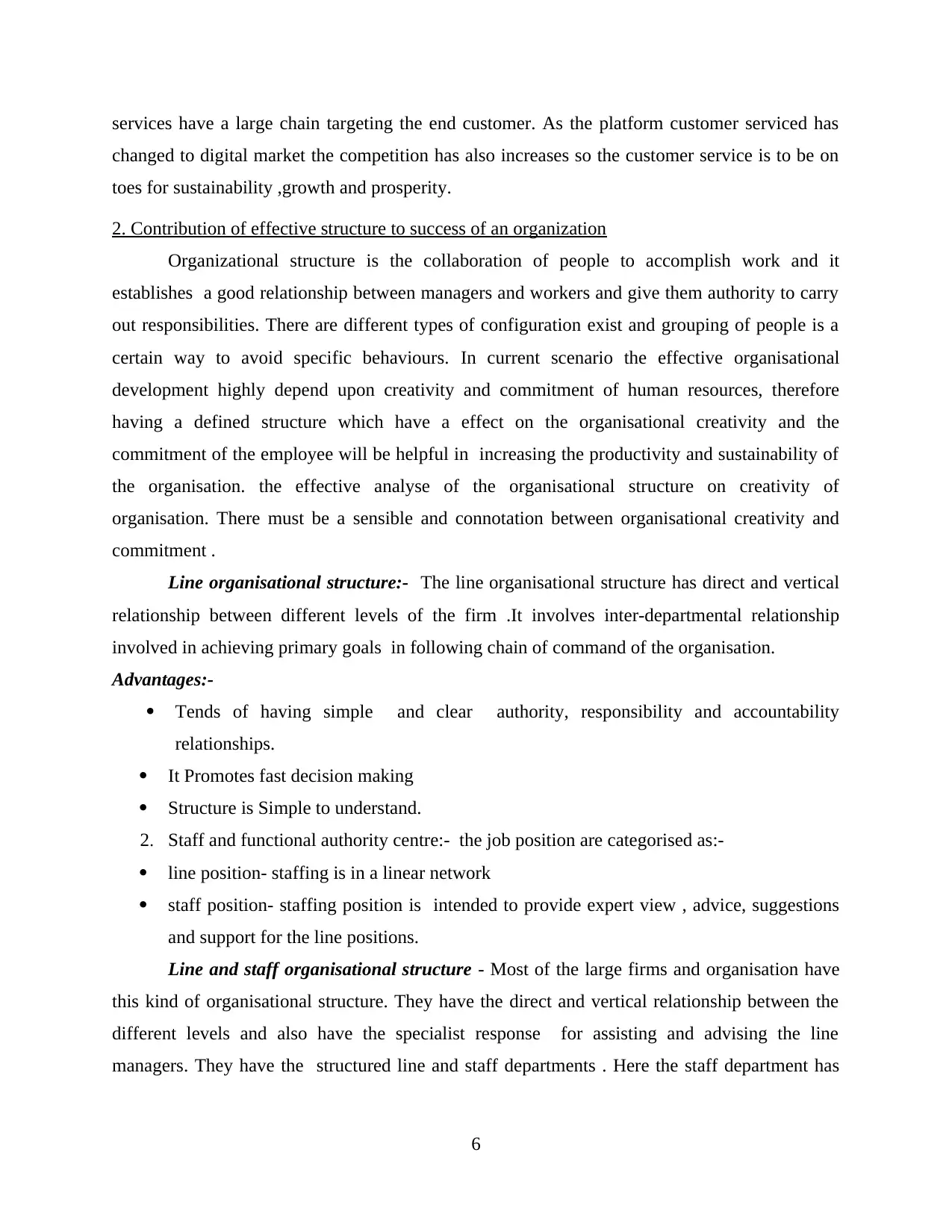
services have a large chain targeting the end customer. As the platform customer serviced has
changed to digital market the competition has also increases so the customer service is to be on
toes for sustainability ,growth and prosperity.
2. Contribution of effective structure to success of an organization
Organizational structure is the collaboration of people to accomplish work and it
establishes a good relationship between managers and workers and give them authority to carry
out responsibilities. There are different types of configuration exist and grouping of people is a
certain way to avoid specific behaviours. In current scenario the effective organisational
development highly depend upon creativity and commitment of human resources, therefore
having a defined structure which have a effect on the organisational creativity and the
commitment of the employee will be helpful in increasing the productivity and sustainability of
the organisation. the effective analyse of the organisational structure on creativity of
organisation. There must be a sensible and connotation between organisational creativity and
commitment .
Line organisational structure:- The line organisational structure has direct and vertical
relationship between different levels of the firm .It involves inter-departmental relationship
involved in achieving primary goals in following chain of command of the organisation.
Advantages:-
Tends of having simple and clear authority, responsibility and accountability
relationships.
It Promotes fast decision making
Structure is Simple to understand.
2. Staff and functional authority centre:- the job position are categorised as:-
line position- staffing is in a linear network
staff position- staffing position is intended to provide expert view , advice, suggestions
and support for the line positions.
Line and staff organisational structure - Most of the large firms and organisation have
this kind of organisational structure. They have the direct and vertical relationship between the
different levels and also have the specialist response for assisting and advising the line
managers. They have the structured line and staff departments . Here the staff department has
6
changed to digital market the competition has also increases so the customer service is to be on
toes for sustainability ,growth and prosperity.
2. Contribution of effective structure to success of an organization
Organizational structure is the collaboration of people to accomplish work and it
establishes a good relationship between managers and workers and give them authority to carry
out responsibilities. There are different types of configuration exist and grouping of people is a
certain way to avoid specific behaviours. In current scenario the effective organisational
development highly depend upon creativity and commitment of human resources, therefore
having a defined structure which have a effect on the organisational creativity and the
commitment of the employee will be helpful in increasing the productivity and sustainability of
the organisation. the effective analyse of the organisational structure on creativity of
organisation. There must be a sensible and connotation between organisational creativity and
commitment .
Line organisational structure:- The line organisational structure has direct and vertical
relationship between different levels of the firm .It involves inter-departmental relationship
involved in achieving primary goals in following chain of command of the organisation.
Advantages:-
Tends of having simple and clear authority, responsibility and accountability
relationships.
It Promotes fast decision making
Structure is Simple to understand.
2. Staff and functional authority centre:- the job position are categorised as:-
line position- staffing is in a linear network
staff position- staffing position is intended to provide expert view , advice, suggestions
and support for the line positions.
Line and staff organisational structure - Most of the large firms and organisation have
this kind of organisational structure. They have the direct and vertical relationship between the
different levels and also have the specialist response for assisting and advising the line
managers. They have the structured line and staff departments . Here the staff department has
6
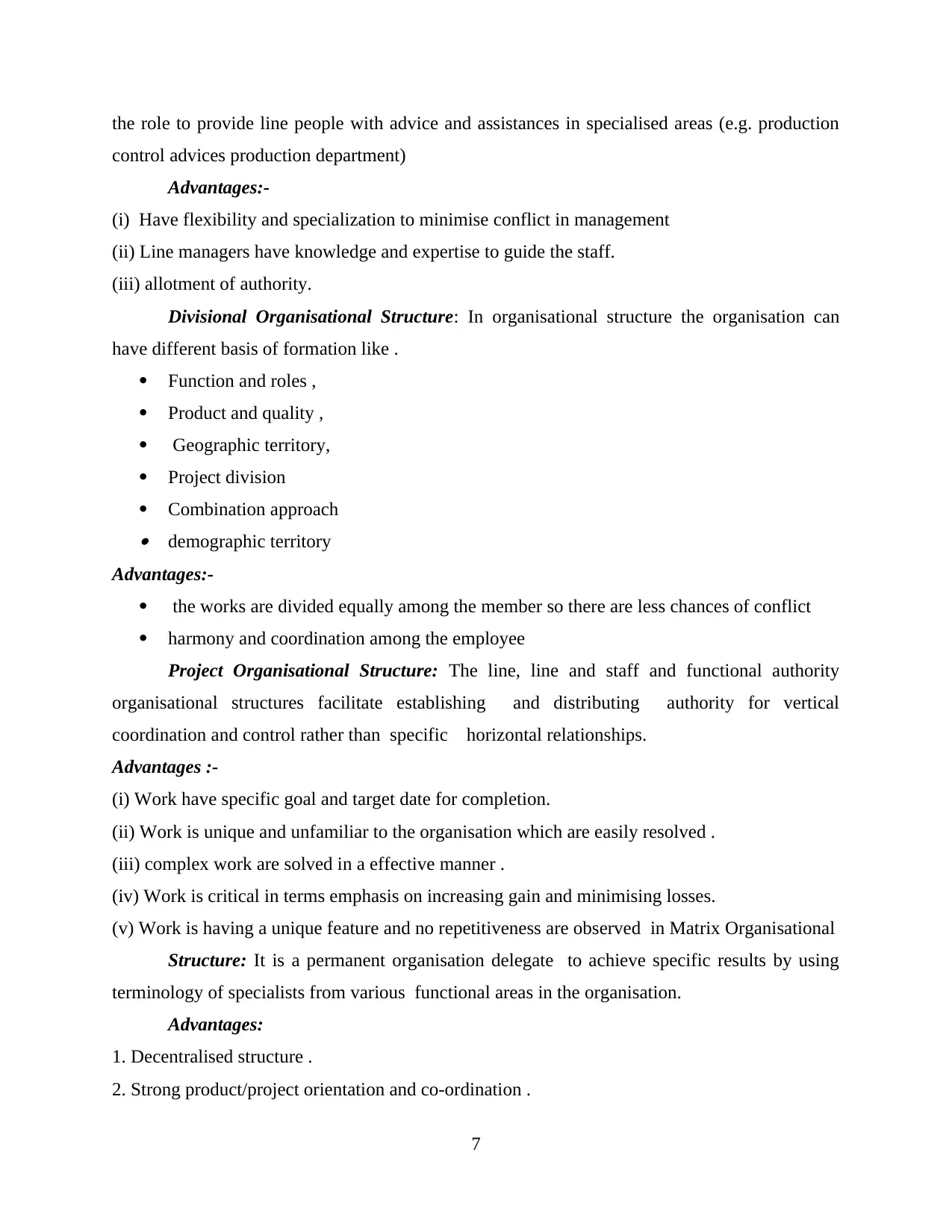
the role to provide line people with advice and assistances in specialised areas (e.g. production
control advices production department)
Advantages:-
(i) Have flexibility and specialization to minimise conflict in management
(ii) Line managers have knowledge and expertise to guide the staff.
(iii) allotment of authority.
Divisional Organisational Structure: In organisational structure the organisation can
have different basis of formation like .
Function and roles ,
Product and quality ,
Geographic territory,
Project division
Combination approach demographic territory
Advantages:-
the works are divided equally among the member so there are less chances of conflict
harmony and coordination among the employee
Project Organisational Structure: The line, line and staff and functional authority
organisational structures facilitate establishing and distributing authority for vertical
coordination and control rather than specific horizontal relationships.
Advantages :-
(i) Work have specific goal and target date for completion.
(ii) Work is unique and unfamiliar to the organisation which are easily resolved .
(iii) complex work are solved in a effective manner .
(iv) Work is critical in terms emphasis on increasing gain and minimising losses.
(v) Work is having a unique feature and no repetitiveness are observed in Matrix Organisational
Structure: It is a permanent organisation delegate to achieve specific results by using
terminology of specialists from various functional areas in the organisation.
Advantages:
1. Decentralised structure .
2. Strong product/project orientation and co-ordination .
7
control advices production department)
Advantages:-
(i) Have flexibility and specialization to minimise conflict in management
(ii) Line managers have knowledge and expertise to guide the staff.
(iii) allotment of authority.
Divisional Organisational Structure: In organisational structure the organisation can
have different basis of formation like .
Function and roles ,
Product and quality ,
Geographic territory,
Project division
Combination approach demographic territory
Advantages:-
the works are divided equally among the member so there are less chances of conflict
harmony and coordination among the employee
Project Organisational Structure: The line, line and staff and functional authority
organisational structures facilitate establishing and distributing authority for vertical
coordination and control rather than specific horizontal relationships.
Advantages :-
(i) Work have specific goal and target date for completion.
(ii) Work is unique and unfamiliar to the organisation which are easily resolved .
(iii) complex work are solved in a effective manner .
(iv) Work is critical in terms emphasis on increasing gain and minimising losses.
(v) Work is having a unique feature and no repetitiveness are observed in Matrix Organisational
Structure: It is a permanent organisation delegate to achieve specific results by using
terminology of specialists from various functional areas in the organisation.
Advantages:
1. Decentralised structure .
2. Strong product/project orientation and co-ordination .
7
⊘ This is a preview!⊘
Do you want full access?
Subscribe today to unlock all pages.

Trusted by 1+ million students worldwide
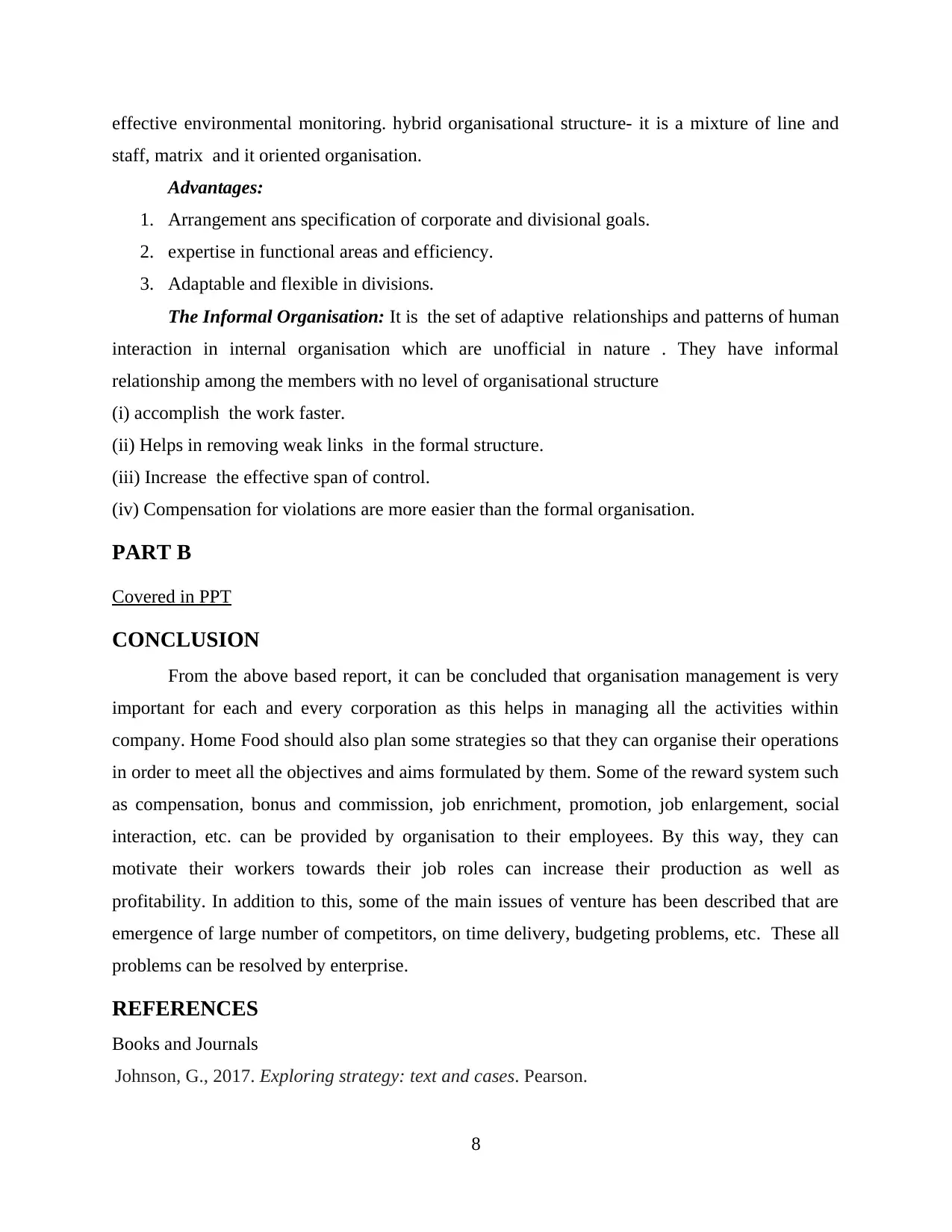
effective environmental monitoring. hybrid organisational structure- it is a mixture of line and
staff, matrix and it oriented organisation.
Advantages:
1. Arrangement ans specification of corporate and divisional goals.
2. expertise in functional areas and efficiency.
3. Adaptable and flexible in divisions.
The Informal Organisation: It is the set of adaptive relationships and patterns of human
interaction in internal organisation which are unofficial in nature . They have informal
relationship among the members with no level of organisational structure
(i) accomplish the work faster.
(ii) Helps in removing weak links in the formal structure.
(iii) Increase the effective span of control.
(iv) Compensation for violations are more easier than the formal organisation.
PART B
Covered in PPT
CONCLUSION
From the above based report, it can be concluded that organisation management is very
important for each and every corporation as this helps in managing all the activities within
company. Home Food should also plan some strategies so that they can organise their operations
in order to meet all the objectives and aims formulated by them. Some of the reward system such
as compensation, bonus and commission, job enrichment, promotion, job enlargement, social
interaction, etc. can be provided by organisation to their employees. By this way, they can
motivate their workers towards their job roles can increase their production as well as
profitability. In addition to this, some of the main issues of venture has been described that are
emergence of large number of competitors, on time delivery, budgeting problems, etc. These all
problems can be resolved by enterprise.
REFERENCES
Books and Journals
Johnson, G., 2017. Exploring strategy: text and cases. Pearson.
8
staff, matrix and it oriented organisation.
Advantages:
1. Arrangement ans specification of corporate and divisional goals.
2. expertise in functional areas and efficiency.
3. Adaptable and flexible in divisions.
The Informal Organisation: It is the set of adaptive relationships and patterns of human
interaction in internal organisation which are unofficial in nature . They have informal
relationship among the members with no level of organisational structure
(i) accomplish the work faster.
(ii) Helps in removing weak links in the formal structure.
(iii) Increase the effective span of control.
(iv) Compensation for violations are more easier than the formal organisation.
PART B
Covered in PPT
CONCLUSION
From the above based report, it can be concluded that organisation management is very
important for each and every corporation as this helps in managing all the activities within
company. Home Food should also plan some strategies so that they can organise their operations
in order to meet all the objectives and aims formulated by them. Some of the reward system such
as compensation, bonus and commission, job enrichment, promotion, job enlargement, social
interaction, etc. can be provided by organisation to their employees. By this way, they can
motivate their workers towards their job roles can increase their production as well as
profitability. In addition to this, some of the main issues of venture has been described that are
emergence of large number of competitors, on time delivery, budgeting problems, etc. These all
problems can be resolved by enterprise.
REFERENCES
Books and Journals
Johnson, G., 2017. Exploring strategy: text and cases. Pearson.
8
Paraphrase This Document
Need a fresh take? Get an instant paraphrase of this document with our AI Paraphraser
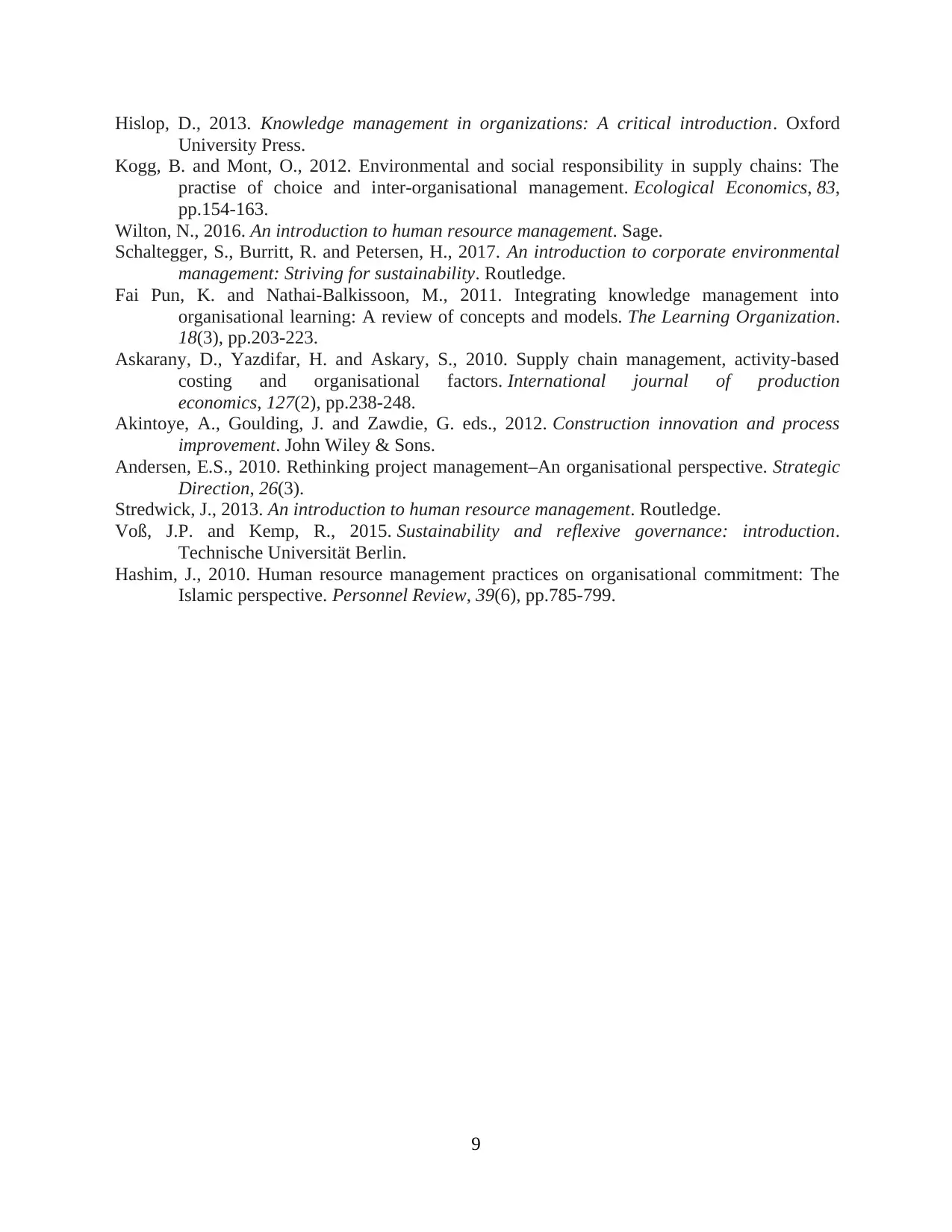
Hislop, D., 2013. Knowledge management in organizations: A critical introduction. Oxford
University Press.
Kogg, B. and Mont, O., 2012. Environmental and social responsibility in supply chains: The
practise of choice and inter-organisational management. Ecological Economics, 83,
pp.154-163.
Wilton, N., 2016. An introduction to human resource management. Sage.
Schaltegger, S., Burritt, R. and Petersen, H., 2017. An introduction to corporate environmental
management: Striving for sustainability. Routledge.
Fai Pun, K. and Nathai-Balkissoon, M., 2011. Integrating knowledge management into
organisational learning: A review of concepts and models. The Learning Organization.
18(3), pp.203-223.
Askarany, D., Yazdifar, H. and Askary, S., 2010. Supply chain management, activity-based
costing and organisational factors. International journal of production
economics, 127(2), pp.238-248.
Akintoye, A., Goulding, J. and Zawdie, G. eds., 2012. Construction innovation and process
improvement. John Wiley & Sons.
Andersen, E.S., 2010. Rethinking project management–An organisational perspective. Strategic
Direction, 26(3).
Stredwick, J., 2013. An introduction to human resource management. Routledge.
Voß, J.P. and Kemp, R., 2015. Sustainability and reflexive governance: introduction.
Technische Universität Berlin.
Hashim, J., 2010. Human resource management practices on organisational commitment: The
Islamic perspective. Personnel Review, 39(6), pp.785-799.
9
University Press.
Kogg, B. and Mont, O., 2012. Environmental and social responsibility in supply chains: The
practise of choice and inter-organisational management. Ecological Economics, 83,
pp.154-163.
Wilton, N., 2016. An introduction to human resource management. Sage.
Schaltegger, S., Burritt, R. and Petersen, H., 2017. An introduction to corporate environmental
management: Striving for sustainability. Routledge.
Fai Pun, K. and Nathai-Balkissoon, M., 2011. Integrating knowledge management into
organisational learning: A review of concepts and models. The Learning Organization.
18(3), pp.203-223.
Askarany, D., Yazdifar, H. and Askary, S., 2010. Supply chain management, activity-based
costing and organisational factors. International journal of production
economics, 127(2), pp.238-248.
Akintoye, A., Goulding, J. and Zawdie, G. eds., 2012. Construction innovation and process
improvement. John Wiley & Sons.
Andersen, E.S., 2010. Rethinking project management–An organisational perspective. Strategic
Direction, 26(3).
Stredwick, J., 2013. An introduction to human resource management. Routledge.
Voß, J.P. and Kemp, R., 2015. Sustainability and reflexive governance: introduction.
Technische Universität Berlin.
Hashim, J., 2010. Human resource management practices on organisational commitment: The
Islamic perspective. Personnel Review, 39(6), pp.785-799.
9

10
⊘ This is a preview!⊘
Do you want full access?
Subscribe today to unlock all pages.

Trusted by 1+ million students worldwide
1 out of 14
Related Documents
Your All-in-One AI-Powered Toolkit for Academic Success.
+13062052269
info@desklib.com
Available 24*7 on WhatsApp / Email
![[object Object]](/_next/static/media/star-bottom.7253800d.svg)
Unlock your academic potential
Copyright © 2020–2025 A2Z Services. All Rights Reserved. Developed and managed by ZUCOL.




